Art Studio
The Magic of Mandalas
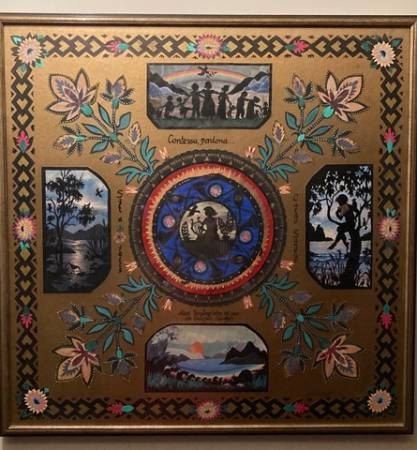
Susann Cook-Greuter, 1986
This page is designed to introduce my friends to the many artistic endeavors I have enjoyed over the years – beginning with the making of personal mandalas. Mandalas are circular designs abundant in nature, spiritual traditions, and the decorative arts. They are a sacred part of Tibetan, Christian and Native American cultures where they serve as a source of meditation and healing.
For me it all began when my friend Susann Cook-Greuter offered to make me a personal mandala in exchange for voice lessons. Taking themes from my life – my favorite music, my interests and work life, she created a very intricate mandala using her skills in Swiss paper cutting and collage. Click here for a key to the meaning of each of the five panels.
This sparked my exploration of mandalas, and I began by coloring templates from the many mandala books that are available today. Then I started designing my own mandalas. I found colored pencils were the most satisfactory medium because they are very portable and are not messy. The absorption of working on a mandala is one of the most enjoyable and centering activities I know.
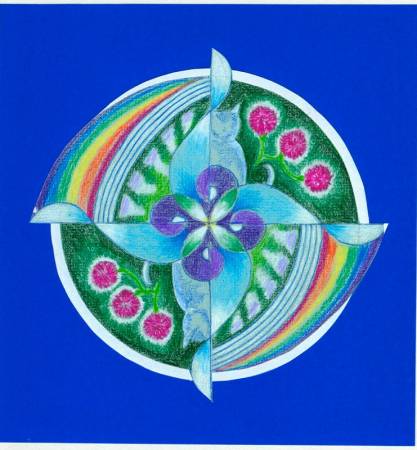
Click on the gallery link below to see some of the designs I have created over the years.
Making Kinetic Mobiles
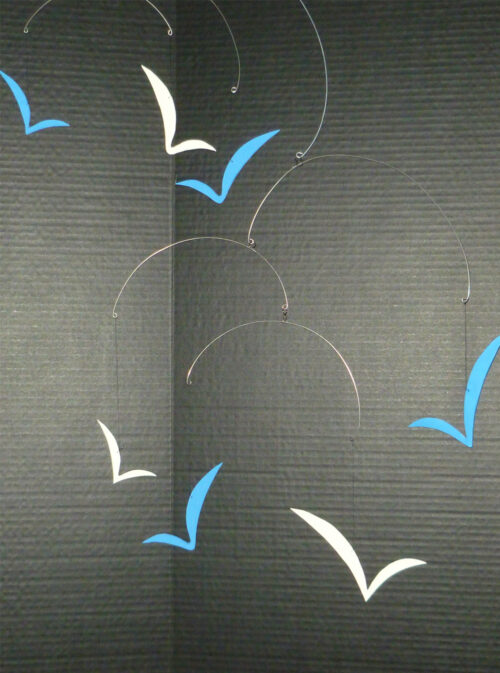
Birds in Flight (2012)
My first attempt to make a mobile was in my high school art class, and I remember being amazed that it balanced!
In 2011 I re-discovered my interest in making kinetic mobiles. I was lucky to find a teacher, Vladimir Barsukov, who led a class for beginners at the Musketaquid Art Center in Concord, MA. His skill and enthusiasm for making mobiles set me on a an exploration of mobiles and how to make them.
The term “mobile”was used to describe the moving sculptures of Alexander Calder who is best known for mobiles that now hang in top museums such as the National Gallery of Art, and in homes and professional buildings world wide.
Calder wrote: “To most people who look at a mobile, it is no more than a series of flat objects that move. To a few though, it may be poetry.”
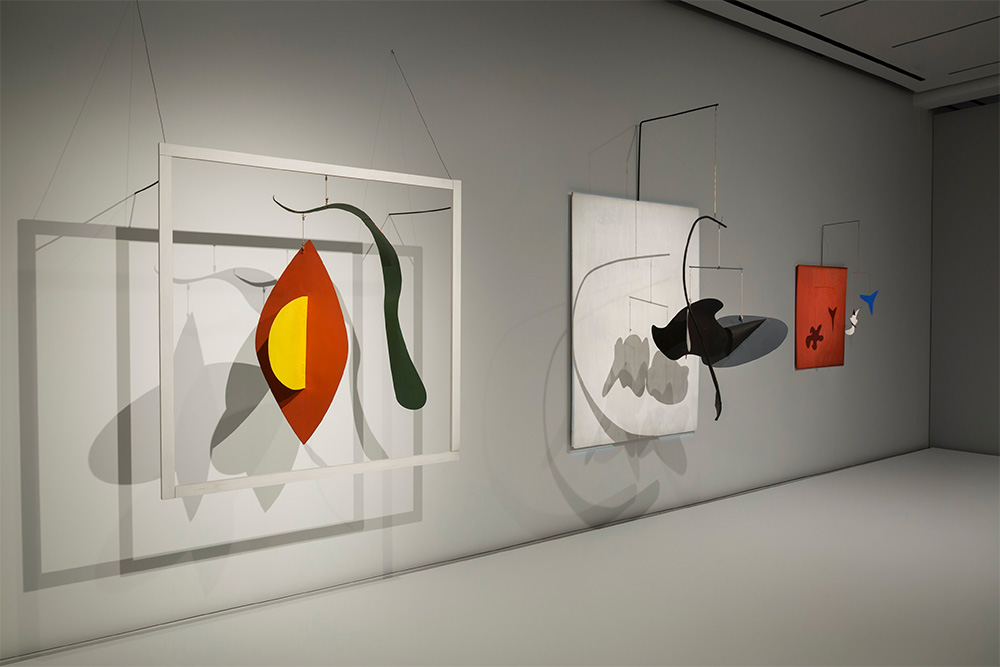
Three Mobiles by Alexander Calder from show at Peabody-Essex Museum, Salem, MA 2014
Why I make Mobiles
Carolyn Kingston
A mobile makes the movement of air visible. A well crafted mobile dances with the slightest stirring of air, whether initiated by heat rising from a radiator, an open window, or someone passing by. To watch a mobile is a centering and meditative experience. I can spend many minutes watching the gentle turns of a mobile and find I am refreshed in the same way as watching the sweep of wind through the tops of trees.
In making a mobile I find creative satisfaction and total absorption in the process. Mobiles are about balance and movement – two qualities I strive for in life.
The options for building a mobile are many and varied. They can be suspended from the ceiling, project out from a wall, (see Calder above) or stand on the ground or on a table top. Calder did all four, and also made huge stabiles: sculptures with no moving parts. The moving parts can be made of any sturdy material: cardboard, cut wood shapes, thin metal sheets, or natural material such as milkweed pods, shells, pine cones etc.
Feel free to experiment!
Harper Inspired Bird Portraits
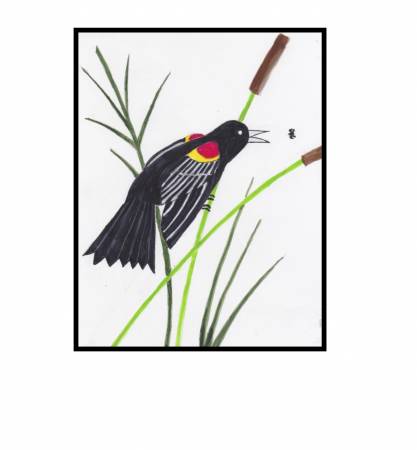
My love of Charley Harper birds began when I was a child living in Lexington.Two of his bird serigraphs were displayed in my parent’s bedroom. They were a gift through their close artist friend, Arthur Lougee, who was the artistic editor of the Ford Times. Arthur was responsible for the first appearance of Harper’s works in the 1957 issue of the magazine.These two prints, of a nuthatch and a chickadee, now grace the walls of our bedroom.
Since his father’s death in 2007, Charley’s son has expanded the reach of his work. My first bird portraits tried to imitate Harper, but quickly evolved into my own style. I have always loved birds and as an adult have continued this interest in frequent walks around Mt. Auburn Cemetery in Cambridge – a favorite location for birders especially during warbler migration in the spring and fall. In the gallery link below, click on any image to start the slide show.
The Adventures of Flat Cat Ruby
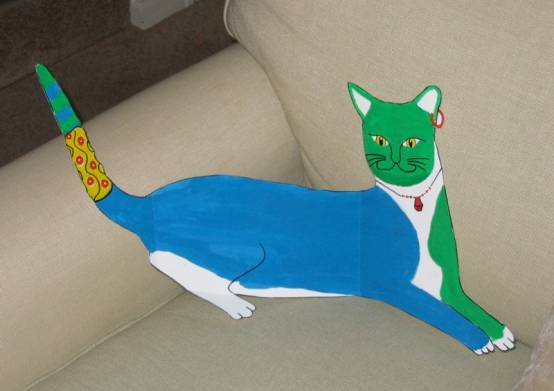
In the spring of 2006 Diana’s friend Mark showed up with a large brown paper cut-out of his grand daughter Katlyne It was traced to size, and colorfully painted in bright pink and blue, with bright yellow hair. Mark kept it folded in an envelope and took “Flat Kat” all over New England to historical landmarks and to visit friends and relations. He documented with photographs, which he sent back to Katlyne as a record of Flat Kat’s adventures on the East coast.
I decided that Flat Kat needed a companion in her travels, so I consulted with Ruby, our grey and white tiger cat. To trace the outline of a cat was impossible, so I took her most lively photograph and enlarged it to size. Ruby decided she wanted “Flat Cat” to be more colorful and chose blue and green, keeping her white vest, boots and mittens. She insisted on a ruby pendant and single earring. I added the polka dot tail warmer.
Flat Cat Ruby and Flat Kat Katlyne first met in Virginia where they went to Toby and Dani’s wedding, and toured the Washington Mall. Click on the link below to view the travels of Flat Cat Ruby.
